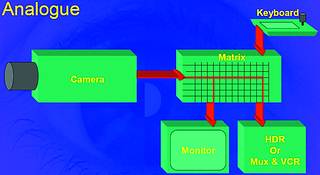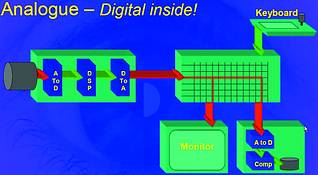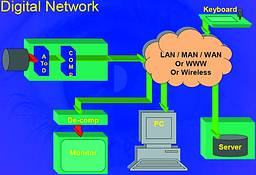
This article provides an insight into the benefits of digital technologies used for transmission purposes and how their qualities far outreach their analog counterparts. It begins with addressing the problems and limitations of analog technologies and then develops into how the application of CCTV over Ethernet and other digital systems is both effective and beneficial for the CCTV user.
The death of analog CCTV?
We are moving inexorably towards a totally digital future. The fact that this is a cliché does not make it any less true. The millions of analog mobile phones now consigned to land-fill sites, and the BBC's decision to phase out analog TV transmissions two years ahead of schedule, bear witness to this. Even a trip to the local DIY store will reveal that CAT 5 is now cheaper than string. So, does this spell the end for analog CCTV as we know it?
Certainly, if you believe the 'digital zealots' in our industry you would believe so.
However, it is important to deal with the merits of digital transmission within the specific requirements of the surveillance market, rather than pursue a technological fad for its own sake. It is surely not coincidental that many of the most outspoken digital proponents cannot offer an analog solution, and can therefore hardly be considered without bias. The situation is further confused by different factions of the digital movement - each promoting specific technologies for compression and network protocols as a 'one-size fits all' panacea. It is hardly surprising that confusion and doubt is commonplace in our industry.
This article is an attempt to present a rational and objective review of the merits of various transmission technologies, from the unbiased perspective of a manufacturer who can provide solutions in the analog, broadband and Ethernet domains. It is presented in as non-technical a way as possible, with a minimum of jargon.
The technologies
Analog transmission is well established and understood. For distances of a few hundred metres the humble coaxial cable provides cost-effective and high quality transmission, and has been doing so since John Logie Baird's pioneering TV experiments in 1925. For greater distances, optical fibre transmission is a more recent but well-established medium, capable of carrying video over a few kilometres. In the context of CCTV, analog cameras are fed via a matrix to analog monitors and by means of multiplexers to an analog VCR. The whole system is usually controlled from a reassuringly chunky keyboard. (See Figure 1). The sight of a coaxial cable linking each component further reassures us that we are in a safe, familiar world.

However, delving further into each of the system components, we find a very different picture (See Figure 2). The video signal makes numerous transitions between the analog and digital worlds on its journey from camera to observer - ranging from digital signal processing in the camera, to digital frame storage in the multiplexer. The trend towards digital recording further emphasises the inexorable digitisation of 'analog' CCTV technology.

Networks linking computers are now commonplace and there are a number of well established and proven standards depending on the amount of data being transmitted (bandwidth), and the needs of users in terms of range, quality and reliability of the data arriving intact. Two of these protocols, asynchronous transfer mode (ATM) and Internet Protocol (IP) over Ethernet, have been adopted for carrying video (along with voice and data) over digital networks.
ATM is a broadband network technology, allowing very large amounts of data to be transmitted at a high rate (bandwidth). It does this by establishing 'virtual circuits', which connect points in the network as if by a physical wire, and can maintain many such links on a single network. These features have important implications for transmitting high quality video with a guaranteed quality of service.
IP is an addressing convention. Think of it as being analogous to a postcode. IP addressing is not limited to any particular type of network, and data on the Internet will often travel over different types of network (eg, ATM and Ethernet) as it moves from one IP address to the next. Over 90% of all networks are IP enabled.
Ethernet is now the most common type of data network. Over 80% of all local area networks are Ethernet-based. Data is sent in packets - small chunks - and reassembled at the receiving point. Imagine sending a poster cut into a thousand pieces and in different envelopes through the Royal Mail and you start to get an idea of the challenges of transmitting video over Ethernet. Thankfully, some video network products use techniques to manage and prioritise video packets and so are able to deliver a defined Class of Service. Whilst this does not guarantee the excellent quality that is achievable with ATM, it can achieve good results within a well-managed network.
Whichever network technology a digital CCTV system is based upon, the building blocks are similar and Figure 3 shows the typical components. The video is digitised and then compressed in an encoder or video server. This will either be a standalone device or integrated into the camera. There are a number of different compression algorithms and methods of achieving the best use of the available bandwidth, eg, varying the frame rate, quality and resolution. The resulting video stream is then sent over the network and received at a client or decoder. This is typically a software application, running on a PC, allowing images to be viewed. Some systems also have a hardware client which enables the video to be viewed on a conventional analog monitor, without any PC present on the network (good news for those who are allergic to computers).

So far, all we have achieved is to get some video onto a wire and off again - not much user benefit there! Importantly, there is now no need for a matrix since the network is carrying out the function of routing video from a particular camera to the required monitor. This is particularly beneficial if the server can 'multicast' - that is, send video to more than one viewer. In this case, many different users can benefit from images that are being captured, eg, in an airport, the customs and baggage handling operations could benefit from the investment originally intended solely for security.
Control of the routing of this video is typically done from an administration computer on the network. However, these applications tend to show their IT roots and may not be optimised for the dynamics of a control room environment. Some advanced CCTV applications also allow the user the option of a more conventional keyboard interface complete with joystick and large function keys, rather than a qwerty 'typewriter' interface. This enables the full benefit of networked CCTV, without the training issues associated with control using a PC.
Finally, most CCTV applications require significant recording and archiving of video.
Here, the network solution can really come into its own. The digitisation and compression that is carried out in the encoder (in or near the camera), is exactly the same function that is carried out in a digital video recorder. In a networked CCTV system, you have already paid for this, so all that remains is for the video stream to be recorded onto the hard disk of a PC. There are solutions available which make it possible to add unlimited recording capacity using standard PCs, running an appropriate software application. In addition, such a network video recorder can be positioned at any point on the network, enabling distributed recording at source, or in the control room.
Which solution?
I have chosen the following five main criteria to help judge the relative merits of each technology:
Image quality - Without a good image, the rest is irrelevant. However, 'good' needs defining as being adequate for the intended purpose, which obviously differs from alarm verification to facial recognition. It is important to understand that the perceived image quality will be determined by the weakest link in the system - be it a used VCR tape, a poorly earthed coaxial cable, or an over-utilised Ethernet connection. Finally, it is worth emphasising that if your perception of digital transmission is flavoured by your latest attempt to view a 'webcam' over the Internet, you need to have a look at a modern networked video solution. Each of these technologies is capable of delivering excellent video.
Cost - This sounds obvious, but it is important to look at the total installed, and lifetime costs of a solution - not just 'how much are the cameras?'. The CCTV content of a typical major installation often equates to less than 30% of the total cost, with the civil engineering and installation making up a major component. Networked solutions can be installed on a 'ring' or 'branch' basis, rather than a 'star' configuration, where every individual video image is carried all the way back to the control station over a separate link. The analog solution for a major project (eg, a rail network or airport) could have hundreds of kilometres of cabling, which could be reduced by 90% with a network solution. It is even possible to have no up-front cost for a digital solution - either using an existing network, or leasing bandwidth from a service provider who has a virtual private network.
Scaleability - This is where a network solution really comes into its own. The 'reach' of digital networks is now global, with many corporations already having made the investment in 'getting wired'. With the World Wide Web and the availability of wireless networking, the provision of video at a distance is simply an IT issue that can be managed with off-the-shelf components. It is also possible to 'plug-and-play' adding new cameras without having to trail coaxial cable around a facility - great in the constant merry-go-round of today's changing world.
Scope of use - Security is often a 'grudge spend'. Despite the industry's best attempts to promote the value of security and loss prevention (to staff, customers and property), it is often difficult to sell these benefits. Bringing in other users, eg, baggage handling in an airport, adds value at minimal extra cost in a networked environment. It is also possible to generate marketing opportunities, or even revenue streams, by using the video transmission for other applications. One shopping mall in the USA is broadcasting some of its video feeds via the Internet to encourage shoppers to visit.
Integration - The progressive digitisation of the world extends far beyond CCTV - the IP-addressable fridge testifies to that! Interoperability of access control, fire and building management systems is greatly simplified if they all operate over a common IP network. Furthermore, the scope to add more value with digital enhancements (eg, automatic number plate or facial recognition systems) is much easier if the images are already within the digital domain.
Conclusions
Any comparison of transmission technologies can only deal in generalities, since much depends on the implementation and functionality of specific equipment. It is also worth bearing in mind that image quality will be determined by the weakest link in the system; true for analog or digital, and that the cost of a network is not an issue if a network already exists and has spare capacity.
In conclusion, it is clear that analog CCTV solutions have many merits and rumours of their demise have been wildly exaggerated. However, many drivers outside our industry are pushing inexorably in a digital direction, and the cost, performance and availability of both the hardware and bandwidth are only going to improve. There is no best technology, but there will be one that is most appropriate for a given installation. Understanding the application, now and in the future, is the only way of selecting the appropriate technology. The only way of guaranteeing the best fit, is to work with a partner who can offer unbiased advice from a multitechnology standpoint.
Dominic Oughton is managing director of Baxall, a leading provider of CCTV solutions, which span analog, broadband ATM and IP/Ethernet technologies.

© Technews Publishing (Pty) Ltd. | All Rights Reserved.